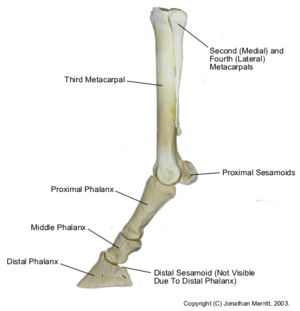Sesamoiditis
| Sesamoiditis | |
|---|---|
| Classification and external resources | |
| Specialty | rheumatology |
| ICD-10 | M86.8 |
| ICD-9-CM | 733.99 |
Sesamoiditis is inflammation of the sesamoid bones.
Humans

Sesamoiditis occurs on the bottom of the foot, just behind the big toe. There are normally two sesamoid bones on each foot; sometimes sesamoids can be bipartite, which means they each comprise two separate pieces. The sesamoids are roughly the size of jelly beans. The sesamoid bones act as a fulcrum for the flexor tendons, the tendons which bend the big toe downward.
Symptoms include inflammation and pain.
Sometimes a sesamoid bone is fractured. This can be difficult to pick up on X-ray, so a bone scan or MRI is a better alternative.[1]
Among those who are susceptible to the malady are dancers, catchers and pitchers in baseball, soccer players, and football players.[2][3]
Horses

In the horse it occurs at the horse's fetlock. The sesamoid bones lie behind the bones of the fetlock, at the back of the joint, and help to keep the tendons and ligaments that run between them correctly functioning.
Usually periostitis (new bone growth) occurs along with sesamoiditis, and the suspensory ligament may also be affected. Sesamoiditis results in inflammation, pain, and eventually bone growth.
Causes
In humans, excessive forces caused by sudden bending upwards of the big toe, high heels, or a stumble can contribute to sesamoiditis. Once the sesamoid bone is injured it can be very difficult to cure, because every time you walk you put additional pressure on the sesamoid bone. Treatment in humans consists of anti-inflammatory medication, cortisone injections, strapping to immobilize the big toe, and orthotics with special accommodations to keep pressure off the affected bone.
In horses, sesamoiditis is generally caused by excess stress on the fetlock joint. Conformation that promotes sesamoiditis include long pasterns, or horses with long toes and low heels.
Notable persons with sesamoiditis
- Mike Fucito, major league soccer player[4]
- Josh Zeid, major league baseball pitcher[5][6][7]
- Melvin Upton, major league baseball player [8]
- JJ O'Donnell, football player for Gateshead FC [9]
References
- ↑ Sports Medicine of Baseball. Retrieved October 16, 2014.
- ↑ The Anatomy of Sports Injuries. Retrieved October 16, 2014.
- ↑ Tarascon Sports Medicine Pocketbook. Retrieved October 16, 2014.
- ↑ "Mike Fucito signs with Sounders FC". The Seattle Times. Retrieved October 19, 2014.
- ↑ "Astros P Zeid needs season-ending foot surgery". ESPN.com. Associated Press. July 30, 2014. Retrieved July 31, 2014.
- ↑ "Astros reliever Josh Zeid to have foot surgery, miss rest of season". Ultimate Astros. Retrieved October 16, 2014.
- ↑ "Carlos Correa switches agents; surgery for Josh Zeid". Ultimate Astros. Retrieved October 16, 2014.
- ↑ "Upton to miss rest of spring training with inflammation in left foot". MLB.com. Retrieved February 27, 2015.
- ↑ "Sunderland's Danny Graham helps fund Gateshead player's foot surgery". theguardian.com. Retrieved May 20, 2015.